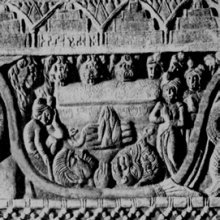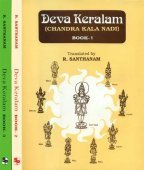Uraga, Ura-ga: 20 definitions
Introduction:
Uraga means something in Buddhism, Pali, Hinduism, Sanskrit, Jainism, Prakrit, Marathi. If you want to know the exact meaning, history, etymology or English translation of this term then check out the descriptions on this page. Add your comment or reference to a book if you want to contribute to this summary article.
Images (photo gallery)
In Hinduism
Purana and Itihasa (epic history)
Source: Wisdom Library: Viṣṇu-purāṇaUraga (उरग) refers to “snakes” and represents a type of Ādhibhautika pain, according to the Viṣṇu-purāṇa 6.5.1-6. Accordingly, “the wise man having investigated the three kinds of worldly pain, or mental and bodily affliction and the like, and having acquired true wisdom, and detachment from human objects, obtains final dissolution.”
Ādhibhautika and its subdivisions (e.g., uragas) represents one of the three types of worldly pain (the other two being ādhyātmika and ādhidaivika) and correspond to three kinds of affliction described in the Sāṃkhyakārikā.
The Viṣṇupurāṇa is one of the eighteen Mahāpurāṇas which, according to tradition was composed of over 23,000 metrical verses dating from at least the 1st-millennium BCE. There are six chapters (aṃśas) containing typical puranic literature but the contents primarily revolve around Viṣṇu and his avatars.
Source: archive.org: Puranic EncyclopediaUraga (उरग).—A class of serpents. Ten daughters were born to Krodhavaśā wife of Kaśyapa. The Uragas were born from the daughter Kadrū and the nāgas were born from the daughter Surasā. (Vālmīki Rāmāyaṇa, Araṇya Kāṇḍa, Sarga 14).
Source: Cologne Digital Sanskrit Dictionaries: The Purana IndexUraga (उरग).—A mythical tribe,1 brothers of Narmadā; māyās relating to.2 Kingdom of;3 see nāgas.4
- 1) Bhāgavata-purāṇa II. 6. 43; 10. 38; Brahmāṇḍa-purāṇa IV. 1. 155; 4. 2; Matsya-purāṇa 5. 1; 6. 29; 23. 39; Vāyu-purāṇa 31. 12; 34. 55; 38. 5; 47. 47; 100. 159; 106. 59; 112. 43.
- 2) Bhāgavata-purāṇa IX. 7. 2; X. 55. 23.
- 3) Matsya-purāṇa 121. 48.
- 4) Viṣṇu-purāṇa II. 5. 12.
Uraga (उरग) is a name mentioned in the Mahābhārata (cf. III.164.30) and represents one of the many proper names used for people and places. Note: The Mahābhārata (mentioning Uraga) is a Sanskrit epic poem consisting of 100,000 ślokas (metrical verses) and is over 2000 years old.

The Purana (पुराण, purāṇas) refers to Sanskrit literature preserving ancient India’s vast cultural history, including historical legends, religious ceremonies, various arts and sciences. The eighteen mahapuranas total over 400,000 shlokas (metrical couplets) and date to at least several centuries BCE.
Ayurveda (science of life)
Toxicology (Study and Treatment of poison)
Source: Shodhganga: Kasyapa Samhita—Text on Visha ChikitsaUraga (उरग) refers to “one who crawls by the chest”, and represents a synonym of Sarpa (“snake”), according to the Paryāyaratnamāla: a lexicon of Āyurveda composed in the 9th Century by Madhava.

Āyurveda (आयुर्वेद, ayurveda) is a branch of Indian science dealing with medicine, herbalism, taxology, anatomy, surgery, alchemy and related topics. Traditional practice of Āyurveda in ancient India dates back to at least the first millenium BC. Literature is commonly written in Sanskrit using various poetic metres.
In Buddhism
Theravada (major branch of Buddhism)
Source: Pali Kanon: Pali Proper NamesA mountain near Himava. In a previous birth, Gosala Thera saw there a rag robe hanging, to which he paid homage (v.l. Udaka and Udangana). ThagA.i.79; Ap.ii.434.
Theravāda is a major branch of Buddhism having the the Pali canon (tipitaka) as their canonical literature, which includes the vinaya-pitaka (monastic rules), the sutta-pitaka (Buddhist sermons) and the abhidhamma-pitaka (philosophy and psychology).
In Jainism
General definition (in Jainism)
Source: The University of Sydney: A study of the Twelve ReflectionsUraga (उरग) refers to “snakes”, according to the 11th century Jñānārṇava, a treatise on Jain Yoga in roughly 2200 Sanskrit verses composed by Śubhacandra.—Accordingly, “Also, consider that the state of being a mighty lord over gods, snakes and men (uraga—suroraganaraiśvaryaṃ), which is like a rainbow, immediately becomes annihilated by itself”.

Jainism is an Indian religion of Dharma whose doctrine revolves around harmlessness (ahimsa) towards every living being. The two major branches (Digambara and Svetambara) of Jainism stimulate self-control (or, shramana, ‘self-reliance’) and spiritual development through a path of peace for the soul to progess to the ultimate goal.
Languages of India and abroad
Pali-English dictionary
Source: BuddhaSasana: Concise Pali-English Dictionaryuraga : (m.) a snake; a creeping animal.
Source: Sutta: The Pali Text Society's Pali-English DictionaryUraga refers to: going on the chest, creeping, i.e. a snake S. I, 69; Sn. 1, 604; J. I, 7; IV, 330; VI, 208; Vv 808; Pv. I, 121 (= urena gacchati ti urago sappass’etaṃ adhivacanaṃ PvA. 63); PvA. 61, 67.
Note: uraga is a Pali compound consisting of the words ura and ga.

Pali is the language of the Tipiṭaka, which is the sacred canon of Theravāda Buddhism and contains much of the Buddha’s speech. Closeley related to Sanskrit, both languages are used interchangeably between religions.
Marathi-English dictionary
Source: DDSA: The Molesworth Marathi and English Dictionaryuraga (उरग).—m S (That goes upon the breast.) A snake or serpent.
Source: DDSA: The Aryabhusan school dictionary, Marathi-Englishuraga (उरग).—m A snake, a serpent.
Marathi is an Indo-European language having over 70 million native speakers people in (predominantly) Maharashtra India. Marathi, like many other Indo-Aryan languages, evolved from early forms of Prakrit, which itself is a subset of Sanskrit, one of the most ancient languages of the world.
Sanskrit dictionary
Source: DDSA: The practical Sanskrit-English dictionaryUraga (उरग).—(-gī f.) [urasā gacchati, uras -gam-ḍa; salopaśca P.III.2.48 Vārt.]
1) A serpent, snake; अङ्गुली- वोरगक्षता (aṅgulī- voragakṣatā) R.1.28,12.5,91. उपगांश्च दिव्यान् (upagāṃśca divyān) Bhagavadgītā (Bombay) 11.15.
2) A Nāga or semi-divine serpent usually represented in mythology with a human face; देवगन्धर्वमानुषोरगराक्षसान् (devagandharvamānuṣoragarākṣasān) Nala.1.28; Manusmṛti 3.196.
3) (puṃ. na.) Lead.
-gā Name of a city; अथोरगाख्यस्य पुरस्य नाथम् (athoragākhyasya purasya nātham) R.6.59.
-gī A female snake.
Derivable forms: uragaḥ (उरगः).
Source: Cologne Digital Sanskrit Dictionaries: Shabda-Sagara Sanskrit-English DictionaryUraga (उरग).—m.
(-gaḥ) A snake. E. uras the breast, and ga who goes, from gam to go, affix ḍa; also uraṅga and uraṅgama.
Source: Cologne Digital Sanskrit Dictionaries: Benfey Sanskrit-English DictionaryUraga (उरग).—i. e. uras-ga (vb. gam). I. m. A snake, [Kirātārjunīya] 3, 33. Ii. f. gī, A female snake, [Prabodhacandrodaya, (ed. Brockhaus.)] 77, 7. Iii. f. gā, The name of a city.
Source: Cologne Digital Sanskrit Dictionaries: Cappeller Sanskrit-English DictionaryUraga (उरग).—[masculine] a snake (lit. going on the breast).
Source: Cologne Digital Sanskrit Dictionaries: Monier-Williams Sanskrit-English Dictionary1) Uraga (उरग):—[=ura-ga] m. ([from] ura = uras [Kātyāyana on Pāṇini 3-2, 48] and ga, ‘breast-going’), a serpent, snake
2) [v.s. ...] a Nāga (semi-divine serpent usually represented with a human face), [Suparṇādhyāya viii, 5; Suśruta; Raghuvaṃśa] etc.
3) [v.s. ...] Name of the Nakṣatra Āśleṣa (presided over by the Nāgas)
4) [v.s. ...] lead, [cf. Lexicographers, esp. such as amarasiṃha, halāyudha, hemacandra, etc.]
5) Uragā (उरगा):—[=ura-gā] [from ura-ga] f. Name of a town, [Mahābhārata]
Source: Cologne Digital Sanskrit Dictionaries: Yates Sanskrit-English DictionaryUraga (उरग):—[ura-ga] (gaḥ) 1. m. A snake.
[Sanskrit to German]
Sanskrit, also spelled संस्कृतम् (saṃskṛtam), is an ancient language of India commonly seen as the grandmother of the Indo-European language family (even English!). Closely allied with Prakrit and Pali, Sanskrit is more exhaustive in both grammar and terms and has the most extensive collection of literature in the world, greatly surpassing its sister-languages Greek and Latin.
Kannada-English dictionary
Source: Alar: Kannada-English corpusUraga (ಉರಗ):—
1) [noun] that which moves on the chest; a snake; a serpent.
2) [noun] any animal of the class Reptilia, vertebrates with scale integument, cold blood, right and left aortic arch, partially divided heart, single occipital condyle, pulmonary respiration; reptile.
3) [noun] (myth.) a class of semi-divine goods with a human face and a serpent body.
Kannada is a Dravidian language (as opposed to the Indo-European language family) mainly spoken in the southwestern region of India.
See also (Relevant definitions)
Starts with (+43): Uraga Jataka, Uraga Sutta, Uraga Vagga, Uragabamdhana, Uragabandha, Uragabhoji, Uragabhushana, Uragabhuvana, Uragadamda, Uragadhara, Uragadhisha, Uragagarbha, Uragageha, Uragahara, Uragaishvarya, Uragakataka, Uragala, Uragamalli, Uragamamdira, Uragamathana.
Ends with (+55): Adaviburaga, Ahibhanuraga, Anuraga, Anyonyanuraga, Arasinaburaga, Atyarthanuraga, Auraga, Baddhanuraga, Bahalanuraga, Bhadraturaga, Biliburaga, Buraga, Cakshuraga, Caturaga, Chakshuraga, Duraga, Gunanuraga, Guraga, Harituraga, Hritoraga.
Full-text (+72): Uragendra, Uragasthana, Uragashana, Auraga, Uragasya, Uragari, Uragasaracandana, Uragabhushana, Uramga, Mahoraga, Naga, Uranga, Uragayava, Uragasaracandanamaya, Urakam, Uragasaracandanacurna, Krishnoraga, Uragaraja, Uramgama, Uragi.
Relevant text
Search found 45 books and stories containing Uraga, Ura-ga, Ura-gā, Uragā; (plurals include: Uragas, gas, gās, Uragās). You can also click to the full overview containing English textual excerpts. Below are direct links for the most relevant articles:
Buddhist records of the Western world (Xuanzang) (by Samuel Beal)
Chapter 5 - Country of Wu-la-shi (Urasha) < [Book III - Eight Countries]
Guide to Tipitaka (by U Ko Lay)
Part 5 - Suttampata Pali < [Chapter VIII - Khuddaka Nikaya]
Brihad Bhagavatamrita (commentary) (by Śrī Śrīmad Bhaktivedānta Nārāyana Gosvāmī Mahārāja)
Verse 1.5.9 < [Chapter 5 - Priya (the beloved devotees)]
Verse 1.6.121 < [Chapter 6 - Priyatama (the most beloved devotees)]
List of Mahabharata people and places (by Laxman Burdak)
Puranic encyclopaedia (by Vettam Mani)
Ramayana (by Manmatha Nath Dutt)
Chapter XVII < [Book 1 - Bāla-kāṇḍa]
Chapter XLI < [Book 1 - Bāla-kāṇḍa]
Chapter LXVII < [Book 1 - Bāla-kāṇḍa]
Related products

